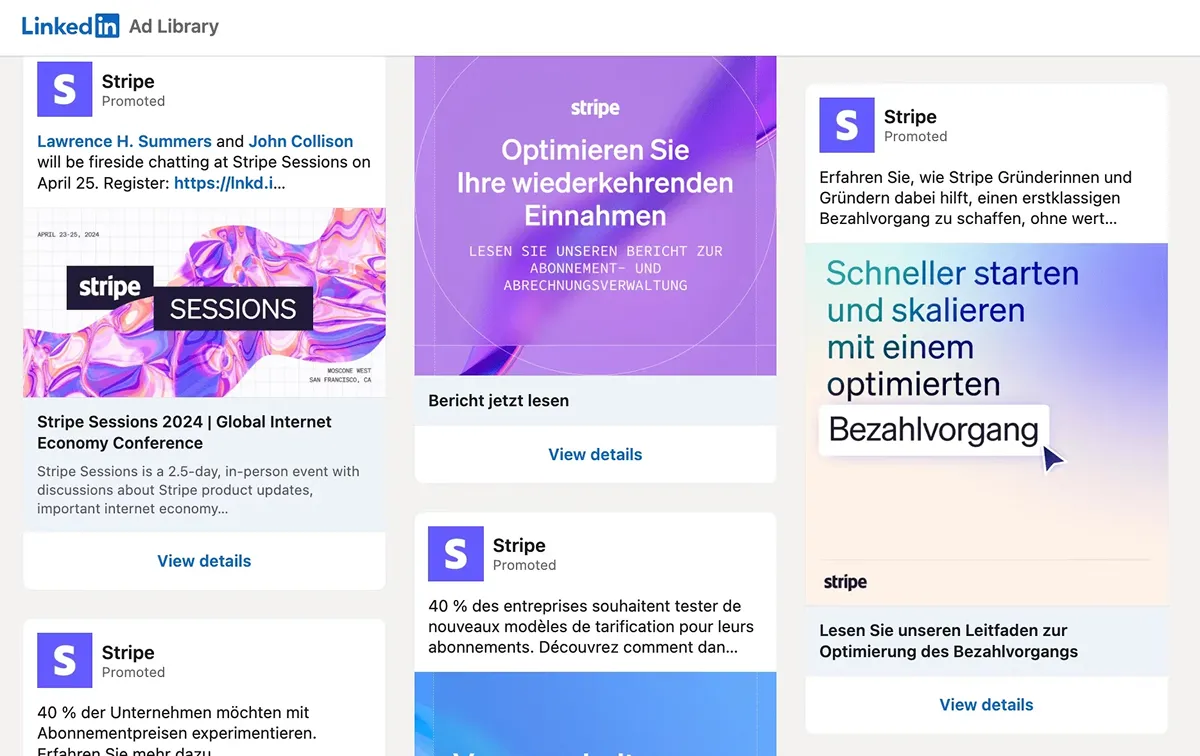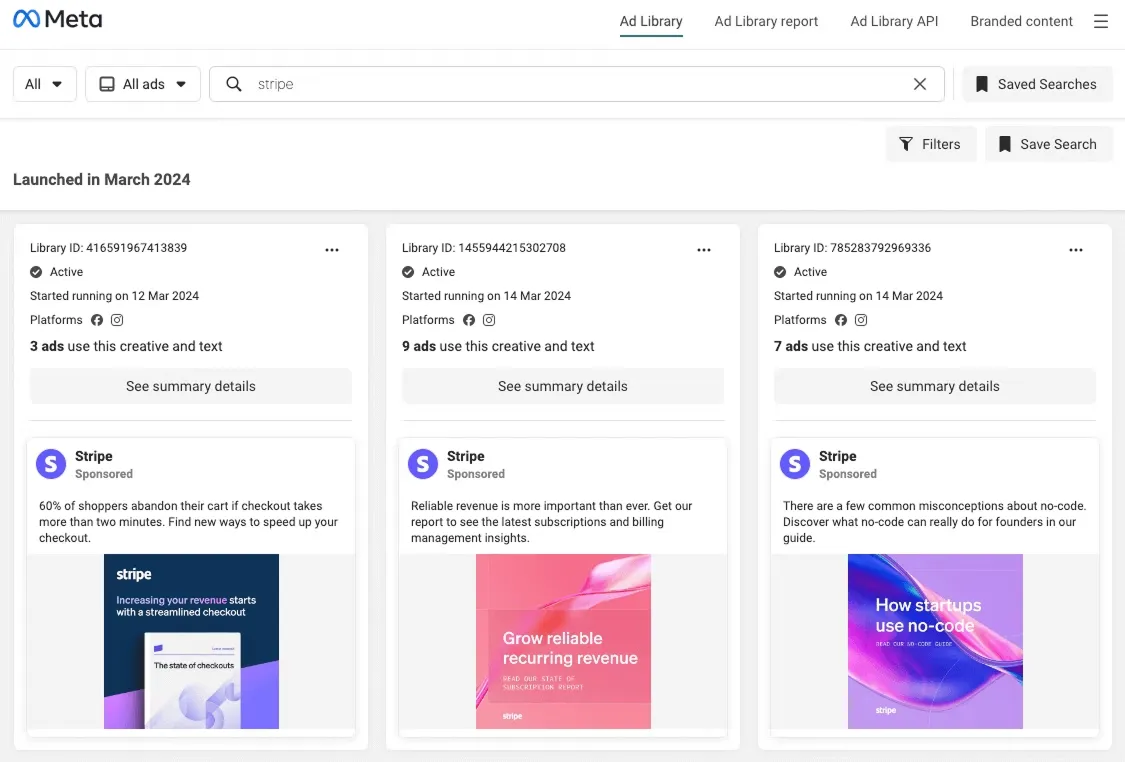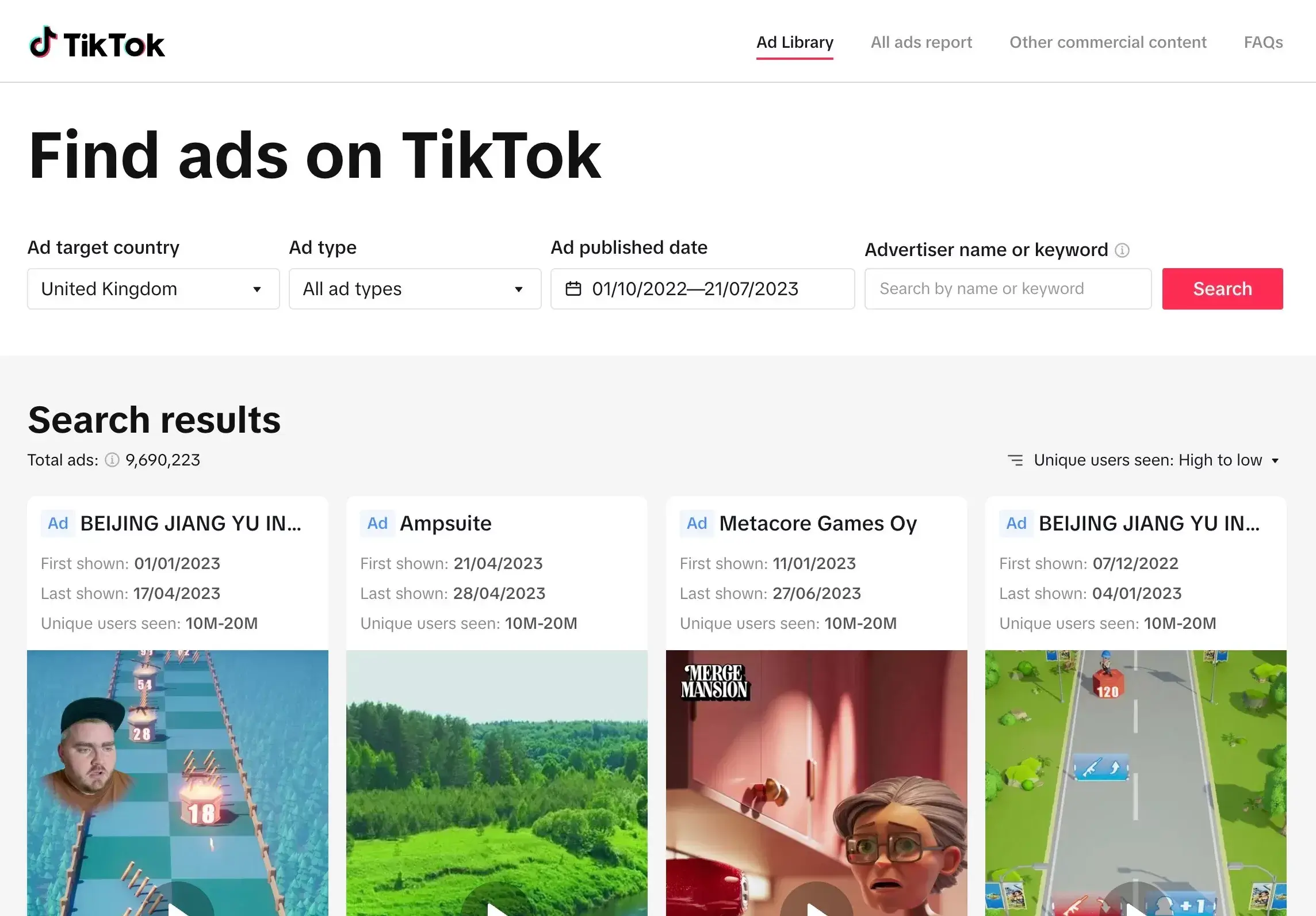If you're a startup founder, head of growth, or performance marketing lead trying to crack B2B paid ads in 2025, you’ve likely asked yourself:
“What are my competitors running? What creatives are working? How do I stay ahead without wasting my budget on guesswork?”
That’s where ad libraries come in!
These are no longer an extra stretch for competitor ad analysis. Tools like the LinkedIn Ad Library, Meta Ad Library, and TikTok Creative Center have become basics to how smart B2B marketers reverse-engineer strategy, get insights on the creative direction to follow, and pressure-test audience assumptions.
In a world where LinkedIn ads convert 6x better than other platforms for B2B and where 93% of marketers still run Facebook ads, visibility into competitor activity has become an important part of the growth playbook for all startups and businesses.
What used to take weeks of manual research or expensive agency retainers can now be handled with a few filters and a bit of pattern recognition. But here’s the catch: not all ad libraries are built equally and certainly not for B2B use cases.
This guide unpacks the practical differences between the LinkedIn Ad Library, Meta Ad Library, and TikTok Creative Center, specifically through a B2B lens. Whether you’re evaluating creative trends, trying to understand targeting strategies, or looking for real-world examples to fuel A/B testing hypotheses, we’ll show you:
- What each ad library actually offers (and what it doesn’t)
- What are the strengths and weaknesses of each ad library
- How to make the most of them with the right stack
- And ultimately, which one gives B2B teams the sharpest edge in 2025
We’ve tested these tools across industries, from SaaS and fintech to AI and enterprise tech. What follows is a real-world comparison backed by usage, data, and strategy.
If your role touches on campaign strategy, creative development, or competitive intelligence, you’re in the right place.
What is an ad library and why B2B marketers use them
What is an ad library?
An ad library is a public-facing repository of ads that have been run on a platform. These repositories are created as a response to increasing demands for transparency in digital advertising. Most major platforms launched them following regulatory pressure, such as the Digital Services Act (DSA) in the EU (European Union) and concerns around political ad accountability.
At their core, these libraries allow users to see who is advertising, what creatives they’re using, and when and where those ads are running. For platforms like Meta, TikTok, and LinkedIn, that includes image and video creatives, copy variations, and limited audience targeting data in some regions.
But while they were originally positioned as tools for watchdogs and policy researchers, marketers quickly realized the strategic potential of these datasets. Especially in B2B, where ad inspiration is sparse, and creative differentiation is critical, these ad libraries have become popular sources of inspiration and insights.
What kind of data do ad libraries offer?
Each ad library varies in what it reveals, but here’s the common ground across platforms:
- Ad creatives: Screenshots, video previews, or playable versions
- Copy and CTAs (Call to Action): Headline, primary text, call-to-action buttons
- Advertiser identity: Company name or verified page
- Run dates: Start/end dates of when the ad was active
- Placement info: In some cases, whether it ran on feed, story, video, etc.
- Targeting data (limited): Especially in the EU, you might see details like location, gender, or age brackets
- Ad status: Whether the ad is active, paused, or archived
On Meta, this information is centralized in the Meta Ad Library, which covers both Facebook and Instagram. TikTok groups this into its Creative Center, a more trend-focused tool. LinkedIn’s library is accessible via Company Page ad transparency and Campaign Manager preview links, showing live sponsored content.
But the magic isn’t just in what’s shown. It’s in how marketers interpret it and that’s where B2B strategies diverge significantly from the usual ecommerce or DTC playbook.
Why B2B marketers are relying on ad libraries for competitor analysis
For B2B teams, these ad libraries are a goldmine for strategic decision-making, especially when budgets are tight, buying cycles are long, and CAC targets are unforgiving.
Here’s how B2B marketers use them:
- Competitor ad tracking: See how others in your niche position their product, segment their value props, or communicate urgency
- Creative inspiration: Identify headline formulas, content hooks, and ad formats (like static vs carousel) that align with the intent
- Trend spotting: Surface common themes across your vertical — from AI-powered messaging to “founder-led” content
- Audience insight: Decode who they might be targeting based on language cues, imagery, or ad placements
- Seasonal intelligence: Compare what a competitor runs during hiring season, budget renewals, or annual product launches
- A/B hypothesis generation: Spot patterns that signal creative fatigue or performance ceilings, and brainstorm smarter variations
Let’s say you run paid social for a SaaS startup targeting HR leaders. By scanning your competitors’ LinkedIn and Meta ads, you can learn whether they’re leading with pain points (e.g., “Cut onboarding time by 50%”) or credibility (e.g., “Trusted by 1,200 teams at Google, Stripe, and Amazon”). You’ll see what visuals they rely on e.g. dashboards, team photos, motion, and what offers they’re pushing e.g. demos, calculators, or gated content.
And in B2B, those small signals often translate to big learnings.
Why ad libraries for competitor analysis matter more in 2025
As platforms get stricter with data privacy and ad personalization evolves, the ability to manually “peek” into the competition’s funnel is one of the few open windows B2B teams still have.
At the same time, the cost of running underperforming ads has never been higher. CPMs (Cost-per-mille) on LinkedIn and Meta are rising. Time-to-lead conversion is lengthening. Most startups don’t have the luxury of testing 20 headlines, they need to get it right in 2.
This is why the smartest B2B teams are researching outside of it first, using ad libraries to reduce guesswork and increase signal density. Furthermore, they are increasingly adopting competitor intelligence tools with features like consolidating all the ad libraries into one place to avoid jumping between tabs.
Now that we understand why ad libraries matter, let’s dig into what each one actually offers and how they stack up when your goal is driving results.
Feature-by-feature breakdown of LinkedIn, Meta, and TikTok ad libraries
Not all ad libraries are created equal, definitely not for B2B needs.
Some are sleek but shallow. Others are clunky but data-rich. Each of these platforms varies in how it defines transparency, what regions it supports, and how much targeting or performance insight you can actually extract.
In this section, we’ll compare the LinkedIn Ad Library, Meta Ad Library, and TikTok Creative Center across five critical dimensions:
- Search and navigation
- Ad creative and copy visibility
- Targeting insights
- Data transparency and limitations
- Overall B2B suitability
Let’s break it down.

User interface of LinkedIn Ad Library
Search filters and user interface
| Platform | Search By | Pros | Cons |
|---|---|---|---|
| Meta Ad Library | Page name, keyword, platform (Facebook/Instagram), country, ad status | Easy-to-use interface, consistent across markets, no login required | Keyword search is fuzzy; no filters for industry or offer type |
| TikTok Creative Center | Keyword, industry, campaign objective, region, format (carousel, video, Spark ads), performance (CTR, CVR - Conversion Rate) | Highly filterable, intuitive layout, great for creative inspiration | More focused on trending content; not ideal for deep competitor research |
| LinkedIn Ad Transparency + Campaign Manager Previews | Advertiser's name, keyword, country, date | See all currently running sponsored content, especially for large companies | No keyword search, no central ad library, hard to filter by campaign type or objective |
Verdict:
If you’re looking for ad discovery at scale, Meta wins. For creative filtering, TikTok excels. But if your goal is to evaluate specific B2B competitors, LinkedIn’s manual route still delivers the most relevant examples, albeit with some level of friction.

User interface of Meta Ad Library
Type of ad content available
| Platform | See | Doesn’t Show | Bonus |
|---|---|---|---|
| Meta | Image, video, carousel creatives, full ad copy, CTA buttons | Post comments, targeting overlays, engagement metrics | Political/social ads show impressions and spend data |
| TikTok | Hook, play-through rate, engagement rate, region, duration | Full targeting logic, landing pages, total ad spend | Filter by ad objective (e.g., conversions, app installs) |
| Full static or video creative, sponsored post copy, CTA buttons | Historical ads (if paused), targeting details, performance metrics | No engagement metrics; insights come from copy structure and tone |
Verdict:
All three provide visual assets and copy, but Meta and TikTok surface more creative context like ad length or intent. LinkedIn stays simple: good for messaging clarity, but not much more.

User interface of TikTok Creative Center
Targeting insights (and what’s missing)
| Platform | What It Shows | Limitations |
|---|---|---|
| Meta (EU-specific) | Demographic breakdown (age, gender, location); sometimes interests or custom audience flags | Outside the EU, targeting insights are minimal |
| TikTok | Aggregate trends by region and industry | Limited targeting data; mostly inferred from ad objective and CTA |
| No explicit targeting data | Audience must be inferred from ad copy cues like job titles, industries, and pain points |
Verdict:
If you're analyzing from the EU, Meta’s DSA-driven breakdowns are invaluable. But globally, B2B marketers need to read between the lines. On LinkedIn, copywriting becomes your targeting signal.
What none of these tools show
This is where expectations need to be managed. Here’s what none of the three ad libraries provide consistently:
- Actual performance metrics (e.g., CTR - Click-through Rate, conversions, ROAS - Return on Ad Spend)
- Total spend (outside of regulated political ads)
- Targeting granularity (especially job title or firmographics in B2B)
- Retargeting or funnel structure
- Engagement or social proof (likes, comments, shares)
- Past ads once paused or deleted
Some of these gaps can be filled with complementary tools like Competitor Ad Intelligence Tool (COIN) by Kaya, SpyFu, Superads, or MagicBrief, which we’ll cover below.
TL;DR: Strengths and weaknesses of the platform
| Platform | Strengths | Weaknesses |
|---|---|---|
| LinkedIn Ad Library | Highly relevant B2B messaging, professional targeting, great for creative tone | No filters, minimal metadata, harder to access old ads |
| Meta Ad Library | Robust filters, large ad volume, visible formats across Instagram & Facebook | No performance metrics, keyword search is limited |
| TikTok Creative Center | Hook-driven creative insights, industry filters, performance proxies | Geared toward DTC/consumer, weak for B2B targeting signals |
Here’s the takeaway from this breakdown: Your choice depends on what you want to analyze. If you’re crafting copy for founders and ops leaders, LinkedIn wins. If you’re validating ad styles or placements, Meta is broader. And if you're exploring scroll-stopping hooks, TikTok provides surprising B2B creative inspiration, especially for brand-led play).
How to use Meta, TikTok, and LinkedIn ad libraries for B2B research
Once you’ve located competitor ads in these libraries, the real work begins.
Because ad libraries don’t hand you the perfect playbook. Rather, they give you raw ingredients. And as a B2B marketer, founder, or performance lead, how you turn those inputs into insight is what makes the difference between a smarter campaign and a wasted sprint.
Here are four powerful, practical ways B2B teams use LinkedIn, Meta, and TikTok ad libraries to inform strategy and gain a creative edge.
For competitor ad tracking and market positioning
If you're entering a crowded space — let’s say B2B payments or employee benefits software — your biggest threat isn’t being ignored. It’s being indistinguishable.
Ad libraries let you answer key strategic questions like:
- What unique angles are our competitors claiming?
- Are they leaning into speed, trust, integrations, or cost?
- Are they naming enterprise customers or leaning on case studies?
- What stage of the funnel are they optimizing e.g. demo requests, lead magnets, or just awareness?
For example, when we analyzed LinkedIn ads from payroll tools like Rippling, Deel, and Papaya Global for one of our clients — Thera, we noticed stark differences in tone and visual execution. Rippling used bright branded colors and direct ROI statements (“Run payroll in 90 seconds”), while Deel pushed credibility and speed-to-hire in global markets.
These cues help you position yourself more clearly. Not to mimic but to differentiate with intent.
For creative benchmarking of ad formats, hooks, and CTAs
One of the most overlooked powers of ad libraries is creative R&D.
You can build a swipe file of:
- Headlines under 50 characters (which LinkedIn says have higher CTR)
- Lead-in copy that challenges status quos (e.g., “Why your onboarding is broken”)
- CTAs that go beyond “Book a demo” (think: “Get the ROI calculator,” “Preview workflow builder”)
- Design patterns: static + overlay, motion-first intros, carousel breakdowns
On TikTok, we’ve seen B2B brands like Grammarly or ClickUp experiment with lo-fi “founder voice” videos and screen-recorded walkthroughs. These might not seem relevant if you're running on LinkedIn or Meta, but they teach you what feels real to users, and how platforms reward native-feeling content.
Also remember: ad fatigue is real. If your carousel ad has been running for 3 months, libraries can help you spot fresh formats that reset scroll behavior.
For trend analysis, seasonality, and frequency patterns
B2B buying cycles are long. But ads still follow seasonal rhythms.
By reviewing the cadence of ads from known players in your vertical, you can uncover:
- Product launch windows (e.g., “We’re introducing our new dashboard…”)
- Hiring sprints (e.g., talent-focused ads in Q2 and Q4)
- Budget timing cues (e.g., “Spend leftover Q4 budget on…”, “Start 2025 strong with…”)
Let’s say you run growth at a B2B analytics company. By reviewing your competitors’ Meta and LinkedIn ad cadence from October to January last year, you might discover a strategic spike in ROI-focused campaigns right before procurement season. This gives you a head start in this year's media planning.
Some teams even use this to forecast frequency signals, e.g., if a competitor keeps running the same copy over 3 months, it likely worked (or they're on autopilot — either way, insight!).
For A/B hypothesis generation and creative validation
Let’s face it, testing is expensive. Especially in B2B, where CACs can creep up fast and sample sizes grow slowly.
Ad libraries offer a zero-cost environment to form educated hypotheses before launching anything. You can:
- Analyze ad variations from a single brand: which ones they scale, which ones disappear
- Identify common testing variables: headline swaps, visual contrast, CTA language
- Detect trends like emoji use, proof elements (“used by 1,200 companies”), or urgency cues (“ending soon”)
We’ve worked with early-stage SaaS teams who used ad library research to pre-narrow their copy variations, such as launching with 4 strong headline variants rather than 12 half-baked ones. The result included faster learning, better ROAS, and far fewer “Why didn’t it work?” post-mortems.
In other words, it’s like stealing someone else’s split test — only legally.
Each of these use cases transforms the ad library from a passive gallery into a dynamic research tool. But it only works if you approach it like a strategist.
In the next section, we’ll cover the limitations and blind spots of these tools. Because while they offer clarity, they also come with caveats, and knowing those can save your team from misreading the signals entirely.
Limitations and risks to watch for
Ad libraries are powerful. But like any tool, they have edges that can cut both ways.
Too many teams treat ad libraries as absolute truth, which is assuming that what’s visible is what works, or that the absence of a certain tactic means it isn’t viable. In reality, these libraries offer a filtered glimpse, not a full view. And if you're not careful, you’ll end up chasing ghosts or copying tactics that died months ago.
Here are the biggest limitations and blind spots you need to know, especially as a B2B marketer or a founder using these tools to inform strategy.
Platform data blind spots
The first thing to understand is that you’re only seeing a fraction of your competitors’ ad insights and information.
Across LinkedIn, Meta, and TikTok:
- Performance metrics are hidden. There’s no CTR, conversion rate, or return on ad spend. You won’t know if an ad you’re viewing was actually effective.
- Spend data is partial at best. Only political ads on Meta show impressions and amount spent and only in specific regions.
- Targeting info is vague or missing. LinkedIn doesn’t show anything. Meta gives some demographic data on the EU. TikTok barely hints at audience logic.
This means you’re looking at the "what" without the "why" or "how well." A gorgeous ad doesn’t mean it worked. A boring one doesn’t mean it failed.
If you’re seeing an ad repeated across time, it may signal success. Or it could just mean the team forgot to turn it off. Either way, you need to triangulate that data with context.
Regional inconsistencies (especially in the EU)
Thanks to regulations like the Digital Services Act (DSA), some platforms are now required to surface more data for ads served in the European Union. This includes targeting parameters and estimated impressions.
That means if you’re based in the EU (or use a VPN), you might see:
- Age ranges, gender breakdowns
- Geo-specific delivery insights
- Duration of campaign run
But this isn’t universal. Outside the EU, much of this insight vanishes.
If your team operates globally, this creates data asymmetry. You might be able to analyze Meta ads with precision in Germany but get a fraction of that context when viewing U.S. campaigns. This is especially important if your B2B buyer journey spans multiple regions.
Risk of over-relying or copying competitors
This is a big one and it’s where a lot of early-stage teams get burned.
The danger isn’t just copying a bad ad. It’s copying a bad ad from a good company and assuming their scale means success.
Here’s what you can’t see in a library:
- How many versions were tested before this ad won
- Whether it's part of a full-funnel sequence or a remarketing nudge
- How it’s being targeted (cold top funnel? Account-based retargeting?)
- Whether the company has brand equity or a massive list you don’t
For example, Stripe can run an ad with just a headline and clean illustration because everyone knows what Stripe does. But your Series A infrastructure startup? Probably can’t.
That’s why your goal isn’t to mirror but to extract the principle i.e., tone, structure, CTA language, and rebuild it to fit your ICP (Ideal Customer Profile), budget, and growth model.
Research fatigue and manual processes
Let’s be real: these tools weren’t designed for power users.
- LinkedIn requires manual checks of each company’s “Ads” tab
- TikTok’s filters can feel optimized for ecommerce, not B2B specificity
- Meta’s keyword search can be frustratingly imprecise
This means ad library research often becomes a manual, time-consuming task, particularly if you're tracking 10+ competitors across multiple platforms.
And because historical ads vanish when paused or deleted, your window to collect intel is limited unless you’re saving assets in real-time.
That’s why many B2B teams pair libraries with third-party tools like:
- MagicBrief, Superads: for saving and organizing creatives
- SpyFu, Adbeat, COIN by Kaya: for analyzing ad frequency, themes, and having everything at one place.
- Foreplay, Madgicx, AdSearch.io: for filtering and tagging at scale
We’ll dig deeper into these in the next section.
To get the most out of ad libraries, you need to treat them as inputs rather than conclusions.
Used blindly, they’re a shortcut to sameness. Used wisely, they’re a springboard to strategy aka a way to reverse-engineer trends, de-risk creative testing, and pressure-test your positioning.
How to level up your competitor ad analysis using complementary tools and integrations
If ad libraries are the microscope, then your stack of complementary tools is the lab where raw observations turn into strategic insight.
Let’s be honest: manually scanning ad libraries is valuable, but it gets exhausting fast. You're juggling screenshots, spreadsheets, tabs, and context gaps across LinkedIn, Meta, and TikTok. And if you're part of a lean B2B team, that’s time better spent launching smarter campaigns.
So how do you go from "cool ad" to "here’s our creative brief for next month"?
You use tools built to extend, enrich, and accelerate ad research, especially for B2B performance teams. Here’s how.
Save and organize ad creative across platforms
Libraries don’t let you bookmark, tag, or search across saved assets. That’s where tools like these come in:
- MagicBrief: Lets you save ads from any platform, tag by theme (e.g., onboarding, product demo, testimonial), and build swipe-boards for internal reviews
- Superads: Offers Chrome extensions for saving and categorizing Meta, TikTok, and YouTube ads. This is helpful for fast-moving teams that want to organize inspiration by funnel stage
- Foreplay.co: Designed for UGC (User-generated content) and DTC brands, but increasingly used by B2B marketers to track ad variations and map creative insights across platforms
Together, these tools let you build a living archive of what’s working in your category, so you’re not starting from scratch each time someone says “We need a new hook.”
Bring all ad libraries in one place and layer in actual ad intelligence with COIN by Kaya
This is where things get serious and specific to B2B.
Competitor Ad Intelligence Tool (COIN) by Kaya is a dedicated competitor ad analysis tool designed to automate ad-level insights for B2B companies, with a focus on:
- Consolidating all ad libraries into one dashboard.
- Tracking ad copy and creative changes across time. This is ideal for spotting messaging pivots.
- Saving ads to get back to them later.
- Monitoring which platform the competitors are putting their most efforts on.
- Estimating their budget across platforms and channels.
- Extracting insights on popular formats.
Unlike public libraries that require you to piece things together manually, COIN builds a continuous timeline of competitor behavior, helping you see not just what they're running now, but how they’ve evolved.
This is beneficial if you’re:
- Repositioning your product
- Launching into a crowded vertical
- Trying to validate new messaging directions
Whether you're a founder building the next B2B AI platform or a marketing lead trying to justify a creative refresh to your CEO, COIN gives you data-backed confidence instead of gut-feel assumptions.
Add performance and audience analytics context
To go from ad to insight, you also need tools that offer insights on traffic signals, audience overlaps, and landing page experience.
Here’s where other integrations help:
- Similarweb, SpyFu: Surface traffic spikes or competitive channel spend
- Google Analytics: Track how competitor-branded search changes after major ad pushes
- Adbeat, iSpionage: See which publishers and placements they’re betting on
- Madgicx or AdEspresso: Help simulate creative testing environments if you’re working on mockups before launch
For example, if a competitor suddenly starts pushing “enterprise onboarding” ads, you can check Similarweb to see if they’re also increasing blog production around security or compliance — hinting at a product shift.
That’s how you go from looking at ads to understanding what’s driving their strategy.
At Kaya, we’ve seen early-stage teams use this stack to:
- Launch campaigns that outperform incumbents on their first iteration
- Spot value prop shifts 3–4 weeks before a public announcement
- Build creative briefs in 60 minutes, not two weeks of brainstorming
This is where ad libraries evolve from static tools into living research ecosystems and give B2B teams the kind of competitive edge that doesn’t just inspire ads, but aligns the whole funnel.
Verdict: which ad library is best for B2B marketers?
After testing all three tools across industries, verticals, and creative strategies, here’s the truth:
There is no single winner, only the right tool for the job.
Each platform’s ad library has strengths. But your job as a B2B strategist, founder, or marketer is to match the tool with your goal. So instead of declaring a universal “best,” let’s break it down based on the three most common B2B research goals.
Best for professional targeting and messaging clarity: LinkedIn Ad Library
LinkedIn gives you the closest look at real-world B2B messaging in action if you're targeting decision-makers, industry professionals, or senior buyers.
- See how competitors phrase value props for CFOs vs. Ops leads
- Analyze tone shifts from “tactical pain” to “strategic outcomes”
- Study how brands tee up enterprise credibility (e.g., name-dropping clients, showing analyst badges, etc.)
Yes, the interface is manual. But the quality of insights, specifically in tone, offer positioning, and voice is unmatched for B2B. And if you pair LinkedIn’s Ads tab with COIN by Kaya, you unlock historical tracking, theme identification, and message analysis.
Choose LinkedIn when your priority is copy strategy, positioning differentiation, or creative alignment to job function.
Best for creative benchmarking and trend scanning: TikTok Creative Center
Surprised? So were we but TikTok isn’t just for DTC and Gen Z anymore.
Its Creative Center:
- Surfaces high-performing visual formats (e.g., top hook rate or completion rate ads)
- Breaks down trending concepts by industry, even for categories like SaaS, fintech, or AI
- Lets you reverse-engineer scroll-stopping techniques that can be adapted for LinkedIn or Meta
We’ve seen B2B brands use TikTok ads as lo-fi MVPs (Minimum Viable Product), testing raw product walkthroughs, founder voiceovers, and swipe-driven carousels that later get refined into premium creative for LinkedIn.
Choose TikTok when you need inspiration, ideation, or format validation, especially for top-of-funnel campaigns where creativity beats polish.
Best for breadth, volume, and campaign discovery: Meta Ad Library
Meta offers the best infrastructure:
- Keyword and page-level search across Facebook and Instagram
- View thousands of ads quickly
- Identify messaging themes at scale across industries and countries
But for B2B you’ll need to do more inference. The ad copy often skews general (especially on Instagram), and without context on targeting or performance, you’ll need to look at landing pages, creative rotation, and ad copy evolution over time to gain real insight.
Still, Meta is unbeatable for:
- High-volume swipe files
- Tracking paid brand campaigns
- Analyzing partner or customer marketing (e.g., co-marketed ads)
Pair it with Superads or MagicBrief for saving and tagging, or use Kaya’s COIN if you're focused on recurring ad copy analysis and market shifts.
Choose Meta when you need scale, speed, or broad landscape analysis, particularly in horizontal B2B markets.
Our overall recommendation: build your stack around your strategy
If you're just starting in B2B ad research, here's a strategic stack that balances speed, signal, and specificity:
- For messaging & ICP fit: LinkedIn Ad Library and COIN by Kaya
- For creative hook inspiration: TikTok Creative Center, COIN by Kaya MagicBrief
- For campaign discovery & swipe files: Meta Ad Library and Superads
Always layer these with context. Pull up their landing pages. Check Similarweb traffic. Monitor G2 category leaders. Because the best ad is only as good as the funnel it belongs to.
FAQ
Is LinkedIn Ads good for B2B?
How can I organize and track competitor ads more effectively?
What is the difference between LinkedIn ads and Meta ads?
Can I use LinkedIn Ad Library to see competitor B2B ads?
What is the LinkedIn Ad Library and how do I access it?
Final thoughts
The bottom line of this entire comparison is that if you’re a B2B founder, marketer, or performance lead still building campaigns in isolation and without peeking into what others are testing, you’re flying blind in a world that rewards insight.
Whether you’re refining messaging, prototyping creative, or building strategy briefs for your CEO, ad libraries offer a front-row seat to your market’s language, offers, and psychological triggers.
But ad libraries alone aren’t enough.
They show you snapshots but not trends. They give you ads without context. And in a high-stakes B2B world where one wrong message can burn $10K overnight, you need more than screenshots.
That’s where competitor ad intelligence tools like COIN by Kaya come in.
COIN doesn’t just show you what your competitors are running today. It shows you how their copy evolves across quarters, which themes repeat across formats, suggesting performance, and how to organize insights around real ICP themes, not just aesthetics.
It’s a powerful way to turn scattered ad inspiration into strategic clarity, helping you ship higher-performing campaigns at a faster pace, get ahead of better-funded competitors, and build internal conviction with real data, not just gut feeling.
So yes, use LinkedIn’s Ads tab. Scroll Meta’s Ad Library. Dive into TikTok’s Creative Center.
But if you want a system, not just a set of tools, it’s time to plug into COIN and make competitor research a core part of how your team operates.
Because the best B2B marketers in 2025 are watching and acting on what they find.


